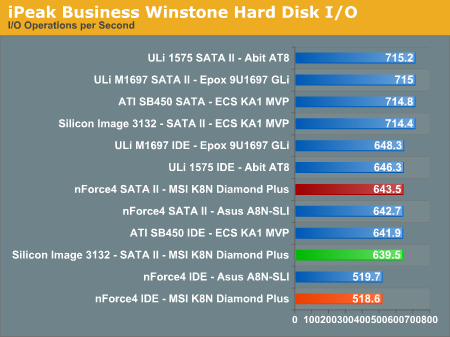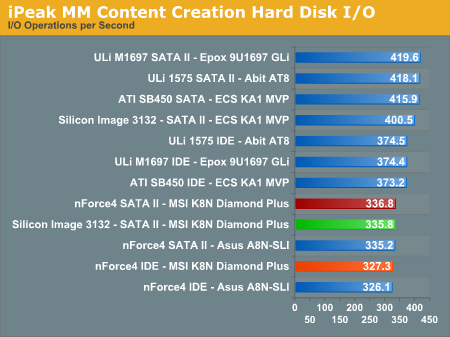Disk Controller Performance
With the variety of disk drive benchmarks available, we needed a means of comparing the true performance of the wide selection of controllers. The logical choice was Anand's storage benchmark first described in Q2 2004 Desktop Hard Drive Comparison: WD Raptor vs. the World. The iPeak test was designed to measure "pure" hard disk performance, and in this case, we kept the hard drive as consistent as possible while varying the hard drive controller. The idea is to measure the performance of a hard drive controller with a consistent hard drive.
We played back Anand's raw files that recorded I/O operations when running a real world benchmark - the entire Winstone 2004 suite. Intel's iPEAK utility was then used to play back the trace file of all IO operations that took place during a single run of Business Winstone 2004 and MCC Winstone 2004. To try to isolate performance differences to the controllers that we were testing, we used the Maxtor MaXLine III 7L300S0 300GB 7200 RPM SATA drive in all tests. The drive was formatted before each test run and a composite average of 5 tests on each controller interface was tabulated in order to ensure consistency in the benchmark.
iPeak gives a mean service time in milliseconds; in other words, the average time that each drive took to fulfill each IO operation. In order to make the data more understandable, we report the scores as an average number of IO operations per second so that higher scores translate into better performance. This number is meaningless as far as hard disk performance is concerned in our tests, as it is just the number of IO operations completed in a second. However, the scores are useful for comparing "pure" performance of the storage controllers in this case.


The performance patterns hold steady across both Multimedia Content IO and Business IO, with the ULi and ATI based disk controllers providing the fastest IO operations followed by the on-board NVIDIA nForce4 SATA controllers. The Silicon Image 3132 controller is able to provide performance almost equal to that of the NVIDIA nForce4 chipset.
With the variety of disk drive benchmarks available, we needed a means of comparing the true performance of the wide selection of controllers. The logical choice was Anand's storage benchmark first described in Q2 2004 Desktop Hard Drive Comparison: WD Raptor vs. the World. The iPeak test was designed to measure "pure" hard disk performance, and in this case, we kept the hard drive as consistent as possible while varying the hard drive controller. The idea is to measure the performance of a hard drive controller with a consistent hard drive.
We played back Anand's raw files that recorded I/O operations when running a real world benchmark - the entire Winstone 2004 suite. Intel's iPEAK utility was then used to play back the trace file of all IO operations that took place during a single run of Business Winstone 2004 and MCC Winstone 2004. To try to isolate performance differences to the controllers that we were testing, we used the Maxtor MaXLine III 7L300S0 300GB 7200 RPM SATA drive in all tests. The drive was formatted before each test run and a composite average of 5 tests on each controller interface was tabulated in order to ensure consistency in the benchmark.
iPeak gives a mean service time in milliseconds; in other words, the average time that each drive took to fulfill each IO operation. In order to make the data more understandable, we report the scores as an average number of IO operations per second so that higher scores translate into better performance. This number is meaningless as far as hard disk performance is concerned in our tests, as it is just the number of IO operations completed in a second. However, the scores are useful for comparing "pure" performance of the storage controllers in this case.


The performance patterns hold steady across both Multimedia Content IO and Business IO, with the ULi and ATI based disk controllers providing the fastest IO operations followed by the on-board NVIDIA nForce4 SATA controllers. The Silicon Image 3132 controller is able to provide performance almost equal to that of the NVIDIA nForce4 chipset.










42 Comments
View All Comments
Odeen - Wednesday, April 12, 2006 - link
Hi,I wish you guys would post the EXACT BIOS (and, as necessary, jumper) settings you used to achieve your best overclocks, plus any issues you had with certain settings, etc. I'd love to see the actual notes from the lab, i.e. "Tried this clock skew value, crashed after X minutes."
While this wouldn't solve every overclocker's question, it would at least set us on the right path in optimizing our own systems, in terms of how certain values affect things.
I imagine you guys have a better understanding on what the BIOS settings do, as opposed to us everyday enthusiasts, who operate primarily on coincidences and conjectures. Especially in this age of hyper-tweakable motherboards with more and more components, it'd be really nice to know, for example, whether the hypertransport multiplier between the "NB" and the "SB" should match the chip-NB hypertransport multiplier, or whether that hypertransport bus speed is independent of HTT, and can be kept at 200/5X regardless of HTT value.
Lastly, have you tried the firewall drivers on this board, and does the firewall STILL cause bluescreens and corrupt downloads?
Gary Key - Wednesday, April 12, 2006 - link
We will need a new server to handle the notes sections for some of these boards. ;-)
We are probably heading in this direction shortly, especially for the enthusiast level boards. I will see what we can do on the next enthusiast level board with a table chart and short descriptions on how we arrived at the settings. I will say this, sometimes leaving most of the settings on Auto works best, the board/bios engineers are usually very smart about the default settings and then when you think all is okay, they hit you with a setting that should never be a default item.
We found on the MSI board, the NB-SB, SB-NB, and CPU-NB HT settings had to be synchronized or the board had stability issues. In fact, the CPU-NB default setting was at 800MHz, we had to change the option to manual, and then bump it up to 1000MHz to match the NB-SB and SB-NB HT settings at stock speeds. It does appear we had an average or below average board for the review, the latest retail sample that MSI pulled from their warehouse was able to post at 318HTT x9 with our test components.
If they are more details you would like to know, please comment or email me.
We tried the firewall with the 6.85 drivers. We could only recreate one particular situation that resulted in a corrupt download. It required the use of BitComet, downloading seven plus files (each over 200MB) concurrently, transferring the files to a media folder, and then unzipping a file while three others were still downloading. It only did it once but it did do it, is it NVIDIA or something else? I personally have not experienced any BSODs or corrupt downloads with the latest drivers, a clean load of XP, and staying away from the P2P software.
We have a new NVIDIA Business Platform system on its way so it should be interesting to see the tweaked ActiveArmor suite and driver updates that NVIDIA has been working on extensively over the last ninety days.
Gary Key - Wednesday, April 12, 2006 - link
Just not my week....Should read - If there are more details you would like to know, please comment or email me.
slashbinslashbash - Tuesday, April 11, 2006 - link
PLEASE learn the difference between "discreet" and "discrete".JarredWalton - Tuesday, April 11, 2006 - link
I don't know about you, but I like my audio solutions to be unobtrusive. Nothing worse than audio that gets in your face with static and stuff.... ;)mbhame - Tuesday, April 11, 2006 - link
"Our initial impression of the MSI K8N Diamond Plus upon opening the box is that it has an extensive feature list, cluttered yet clean layout, heat-pipe cooling system, and that the overall quality of components utilized by MSI is very good."...how can a layout be 'cluttered yet clean'?
JarredWalton - Tuesday, April 11, 2006 - link
Cluttered in that there is a LOT of stuff; clean in that it still works and there aren't any issues with connecting everything. It's an oxymoron, like "little giant". :)nullpointerus - Tuesday, April 11, 2006 - link
Now I know how to describe my room.nullpointerus - Tuesday, April 11, 2006 - link
Where are these PCIe 1x cards I've been hearing about? What exactly is available on PCIe besides video/network cards? I've heard that it's going to be a very long, slow transition to PCIe for sound cards due to noise/power issues with the spec.DigitalFreak - Tuesday, April 11, 2006 - link
See http://www.siig.com/productList.asp?pid=1013&c...">this page for examples. I do wish they made PCI-E sound cards though.